⑩ Sectioning
Large paraffin blocks
Use a microtome to cut tissue blocks which are not mounted on a wooden block.
- Prepare a set for mounting the paraffin blocks onto a metal specimen stage, including a block, electric soldering iron, ruler, fish-slicing knife, and air cleaner.
- Measure paraffin block sizes with a ruler and determine the appropriate glass slide sizes. Slice off the excess paraffin with a fish-slicing knife to fit the section onto a glass slide.
- First, using paraffin, coat the surface of the metal specimen stage.
|
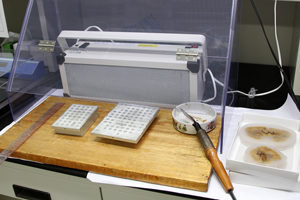 |
- After the paraffin block is placed on the stage, melt the paraffin surrounding the paraffin block with an electric soldering iron.
- The paraffin block is fixed to the stage by melting the paraffin coating the stage and paraffin blocks, which fuses them together.
!attention!
It is not necessary to melt the paraffin on the bottom surface of the paraffin blocks.
|
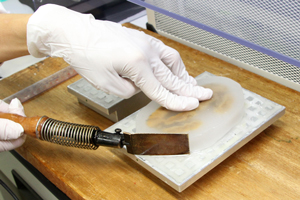 |
- Extra paraffin can be melted and added as needed when there are gaps between the paraffin blocks and stage or areas where the electric soldering iron may come into contact with the sample because there is only a thin layer of paraffin surrounding the paraffin blocks.
|
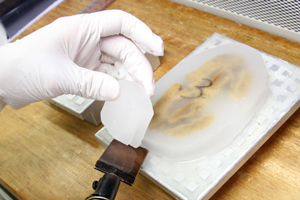 |
- After this step, mounting the paraffin blocks to the stage is complete.
|
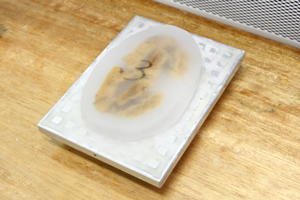 |
- Fix the paraffin blocks to the microtome.
|
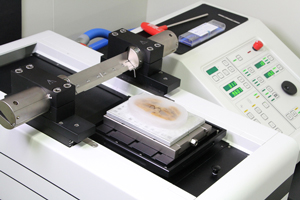 |
- Fine-adjust the paraffin blocks to make them horizontal to the blade.
|
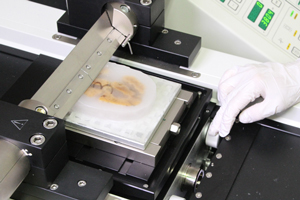 |
- Attach a new blade for rough cutting.
- Use the new blade previously used for main cutting as the new blade for rough cutting.
- We use Feather Microtome Blades S35L as our new blades.
- Adjust the mounting angle of the paraffin block so that the shadow of the new blade reflected in the paraffin block appears to be a certain thickness.
|
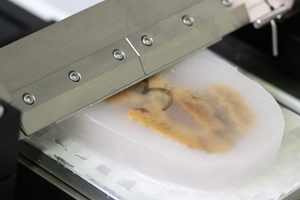 |
- Trim until the cut surface appears. Completely expose the tissue surface, while reducing the tissue as little as possible.
|
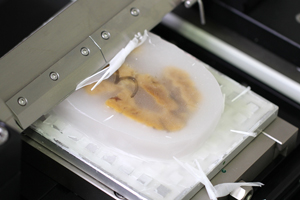 |
- Always keep the areas surrounding the microtome clean by brushing away the paraffin shavings with a large brush and vacuuming them.
|
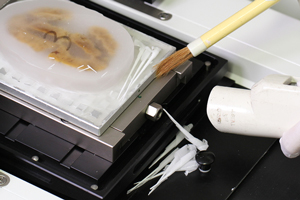 |
- Attach a new blade for main cutting to the microtome.
- Attaching the new blade in the same position as the new blade for rough cutting will minimize tissue loss resulting from new blade replacement.
- After attaching the new blade, adjust the section thickness.
|
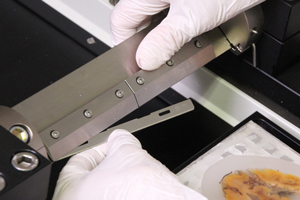 |
- A small brush and spatula are useful for scooping up thinly sliced sections. We made this spatula by shaving down disposable chopsticks. Cardboard can also be used instead of a spatula.
- Premoisten the spatula and small brush in distilled water.
|
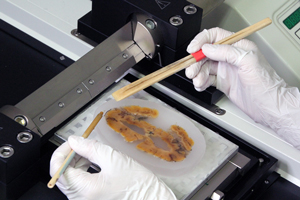 |
- Blowing on the slice during sectioning moistens the tissue, which makes the sectioning smoother.
- It is better to use an automatic humidifier for sectioning.
|
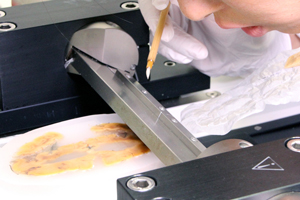 |
- Pick up the section using the small brush and spatula. The section can be cleanly picked up if the brush and spatula are sufficiently moistened.
|
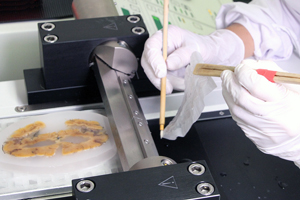 |
- Float the thinly sliced sections in distilled water containing acetic acid.
|
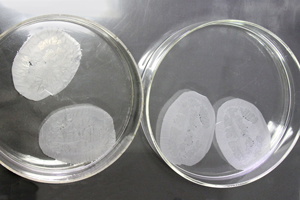 |
- If water droplets form on the section, wipe them off immediately with a Kimwipe or other suitable material. If the droplets remain, then the affected area will swell.
|
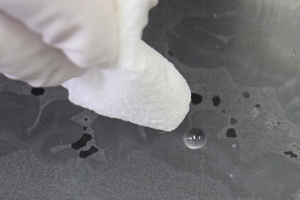 |
- Place the section on a glass slide using a small brush.
|
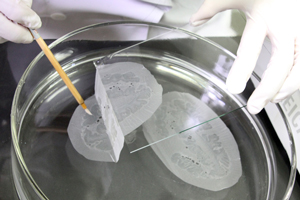 |
- After raising the section out of the distilled water.
|
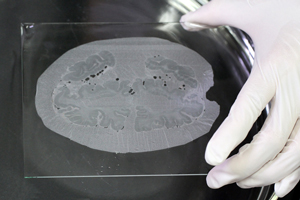 |
- Float the section by gently submerging the glass slide in 40 °C distilled water within a tissue floating warm-water bath.
- Float the section for a few seconds to stretch out the wrinkles.
|
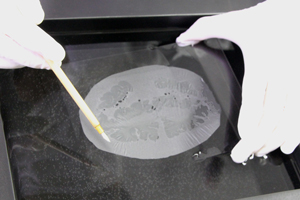 |
- Once the section has stretched, place it on a glass slide using a small brush.
|
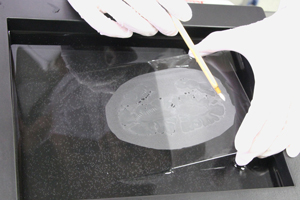 |
- After raising the section out of the tissue floating warm-water bath.
|
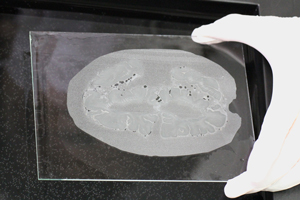 |
- Place the glass slide on two-ply filter paper.
|
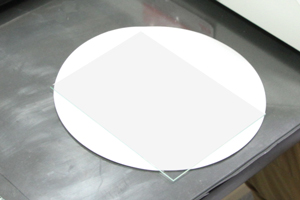 |
- Place wetted two-ply filter paper on the glass slide and hold it with your hand.
|
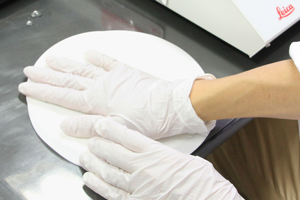 |
- Roll the roller 2–3 times.
|
 |
- Dry the glass slide on the paraffin stretcher.
- Leave the section until it has completely dried.
|
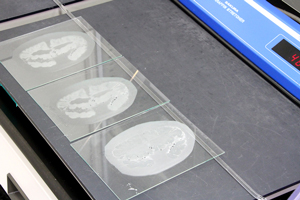 |
- After sectioning is complete, remove the paraffin block from the microtome and stage.
- The paraffin block can be easily removed by placing the blade of the fish-slicing knife between the paraffin block and stage and exerting force in the vertical direction.
|
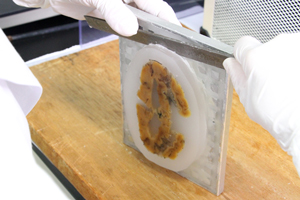 |
- After cleanly removing the paraffin block.
|
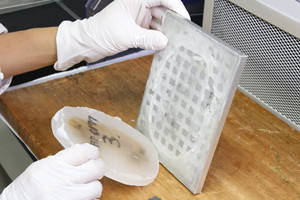 |
- Cover the cut surface of the paraffin block with melted paraffin.
|
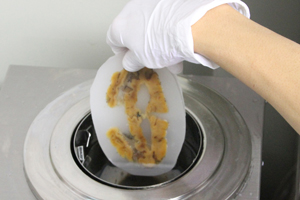 |
- Paraffin block with the cut surface coated in paraffin.
|
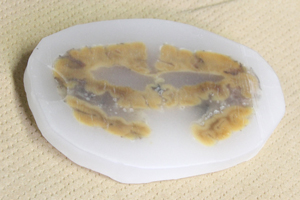 |
Issues to consider during sectioning
- It is useful to place a lid over the distilled water and tissue floating warm-water bath to prevent dust from adhering to the thinly sliced section.
|
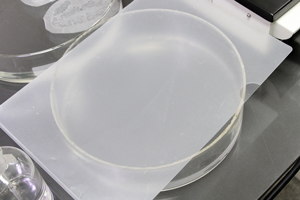 |
Coating the glass slides
The glass slides used for large paraffin blocks are made to order. If we request glass slides with coating, then the cost becomes very expensive. Therefore, we purchase non-coated glass slides and coat them ourselves during sectioning.
|
|
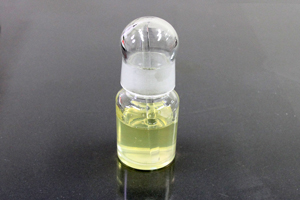 |
- Apply a small amount of the egg white-glycerin to the glass slide.
|
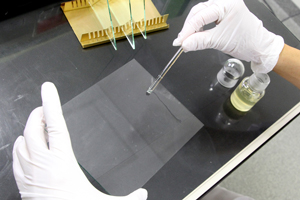 |
- Smear egg white-glycerin on the surface of the glass slide with a Kimwipe or another suitable material.
|
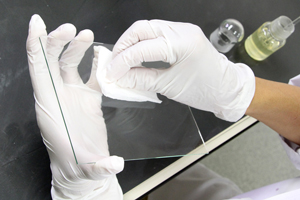 |

































